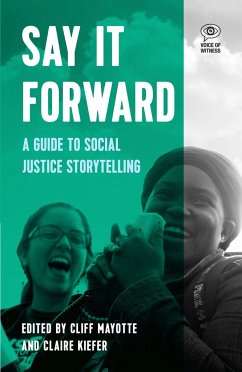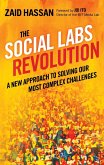Say It Forward
A Guide to Social Justice Storytelling
Herausgeber: Mayotte, Cliff; Keifer, Claire
22,99 €
inkl. MwSt.
Versandfertig in über 4 Wochen

11 °P sammeln
Say It Forward
A Guide to Social Justice Storytelling
Herausgeber: Mayotte, Cliff; Keifer, Claire
- Broschiertes Buch
- Merkliste
- Auf die Merkliste
- Bewerten Bewerten
- Teilen
- Produkt teilen
- Produkterinnerung
- Produkterinnerung
A DIY guide for social justice oral history projects.
Andere Kunden interessierten sich auch für
![Critical Reflexive Research Methodologies Critical Reflexive Research Methodologies]() Critical Reflexive Research Methodologies29,99 €
Critical Reflexive Research Methodologies29,99 €![Survey Methods in Social Investigation Survey Methods in Social Investigation]() C a MoserSurvey Methods in Social Investigation90,99 €
C a MoserSurvey Methods in Social Investigation90,99 €![The Social Labs Revolution The Social Labs Revolution]() Zaid HassanThe Social Labs Revolution17,99 €
Zaid HassanThe Social Labs Revolution17,99 €![Applied Meta-Analysis for Social Science Research Applied Meta-Analysis for Social Science Research]() Noel A CardApplied Meta-Analysis for Social Science Research58,99 €
Noel A CardApplied Meta-Analysis for Social Science Research58,99 €![Elements of Research Design Elements of Research Design]() Titus HjelmElements of Research Design40,99 €
Titus HjelmElements of Research Design40,99 €![Writing the World of Policing Writing the World of Policing]() Writing the World of Policing38,99 €
Writing the World of Policing38,99 €![Japan and the Enemies of Open Political Science Japan and the Enemies of Open Political Science]() David WilliamsJapan and the Enemies of Open Political Science73,99 €
David WilliamsJapan and the Enemies of Open Political Science73,99 €-
-
-
A DIY guide for social justice oral history projects.
Hinweis: Dieser Artikel kann nur an eine deutsche Lieferadresse ausgeliefert werden.
Hinweis: Dieser Artikel kann nur an eine deutsche Lieferadresse ausgeliefert werden.
Produktdetails
- Produktdetails
- Verlag: Haymarket Books
- Seitenzahl: 288
- Erscheinungstermin: 18. Dezember 2018
- Englisch
- Abmessung: 216mm x 140mm x 20mm
- Gewicht: 363g
- ISBN-13: 9781608469581
- ISBN-10: 1608469581
- Artikelnr.: 50908371
- Herstellerkennzeichnung
- Libri GmbH
- Europaallee 1
- 36244 Bad Hersfeld
- gpsr@libri.de
- Verlag: Haymarket Books
- Seitenzahl: 288
- Erscheinungstermin: 18. Dezember 2018
- Englisch
- Abmessung: 216mm x 140mm x 20mm
- Gewicht: 363g
- ISBN-13: 9781608469581
- ISBN-10: 1608469581
- Artikelnr.: 50908371
- Herstellerkennzeichnung
- Libri GmbH
- Europaallee 1
- 36244 Bad Hersfeld
- gpsr@libri.de
Cliff Mayotte is the education program director with Voice of Witness. He previously edited The Power of the Story: The Voice of Witness Teachers Guide to Oral History. Claire Kiefer is the author of Bear Witness. She was a Voice of Witness curriculum specialist and currently works at the Georgia Capital Defender.
Introduction: Making the Invisible Visible
Section One: Conducting Community Oral Histories: Approaches,
Methodologies, and Ethics
History on a Human Scale
Types of Oral Histories
1. Historical or Cultural Memory Transfer
2. Community or Neighborhood History
3. Addressing Injustice or Seeking Change through Oral History
4. Oral History in Educational Settings
Essential Questions and Ethics
1. Oral History: An “Experiment in Equality”
2. Why Should I Share My Story with You? Ownership, Identity, and
Storytelling
3. How Do I Find Narrators for my Oral History Project?
4. Creating Safe/Brave Spaces for Sharing Stories
5. Protecting Narrator Safety
6. Power, Privilege, and Representation in Oral History
7. Outsider/Insider Dynamics
8. Changing Directions in Oral History Projects
9. Editing Oral History Transcripts: Honoring Your Narrator’s Voice
10. Self Care, Compassion Fatigue, and Developing a Capacity to Listen to
Difficult Stories
Section Two: Community Oral History Case Studies
A Note on the Case Studies
1. Behind the Wire: Mandatory Detention in Australia by Andre Dao and
Sienna Merope
2. OG Told Me by Pendarvis Harshaw
3. After the Disaster: Rebuilding Lives and Communities in Fukushima by
Jon Funabiki
4. Re-entry Stories: Life after Prison and Jail by Claire Kiefer
5. Unsettled: Relocating After Katrina by Eric Marshall
6. Our Town, Our Stories by Cliff Mayotte
7. Resilience: Elders in East Harlem by Lauren Taylor
8. DREAMers Testimoniando by Shelby Pasell
9. Tales of Tar Sands Resistance by Stephanie G. Thomas
10. Cycles of Domestic Violence by Ashley Jacobs 225
11. Project LRN (Listening to Residents and Neighbors) by Genevra
Gallo-Bayiates
12. Long Live The King: Fishing in Santa Cruz Harbor by Katie Kuszmar
Section Three: Community Storytelling and Oral History Resources
1. Getting Started: A Quick Guide to Setting up Your Oral History
Project
2. Media Options for Sharing Stories
3. Oral History Resources
4. Trauma & Self-Care Resources
Acknowledgements
About Voice of Witness
About the Editors/ About the Contributors
Section One: Conducting Community Oral Histories: Approaches,
Methodologies, and Ethics
History on a Human Scale
Types of Oral Histories
1. Historical or Cultural Memory Transfer
2. Community or Neighborhood History
3. Addressing Injustice or Seeking Change through Oral History
4. Oral History in Educational Settings
Essential Questions and Ethics
1. Oral History: An “Experiment in Equality”
2. Why Should I Share My Story with You? Ownership, Identity, and
Storytelling
3. How Do I Find Narrators for my Oral History Project?
4. Creating Safe/Brave Spaces for Sharing Stories
5. Protecting Narrator Safety
6. Power, Privilege, and Representation in Oral History
7. Outsider/Insider Dynamics
8. Changing Directions in Oral History Projects
9. Editing Oral History Transcripts: Honoring Your Narrator’s Voice
10. Self Care, Compassion Fatigue, and Developing a Capacity to Listen to
Difficult Stories
Section Two: Community Oral History Case Studies
A Note on the Case Studies
1. Behind the Wire: Mandatory Detention in Australia by Andre Dao and
Sienna Merope
2. OG Told Me by Pendarvis Harshaw
3. After the Disaster: Rebuilding Lives and Communities in Fukushima by
Jon Funabiki
4. Re-entry Stories: Life after Prison and Jail by Claire Kiefer
5. Unsettled: Relocating After Katrina by Eric Marshall
6. Our Town, Our Stories by Cliff Mayotte
7. Resilience: Elders in East Harlem by Lauren Taylor
8. DREAMers Testimoniando by Shelby Pasell
9. Tales of Tar Sands Resistance by Stephanie G. Thomas
10. Cycles of Domestic Violence by Ashley Jacobs 225
11. Project LRN (Listening to Residents and Neighbors) by Genevra
Gallo-Bayiates
12. Long Live The King: Fishing in Santa Cruz Harbor by Katie Kuszmar
Section Three: Community Storytelling and Oral History Resources
1. Getting Started: A Quick Guide to Setting up Your Oral History
Project
2. Media Options for Sharing Stories
3. Oral History Resources
4. Trauma & Self-Care Resources
Acknowledgements
About Voice of Witness
About the Editors/ About the Contributors
Introduction: Making the Invisible Visible
Section One: Conducting Community Oral Histories: Approaches,
Methodologies, and Ethics
History on a Human Scale
Types of Oral Histories
1. Historical or Cultural Memory Transfer
2. Community or Neighborhood History
3. Addressing Injustice or Seeking Change through Oral History
4. Oral History in Educational Settings
Essential Questions and Ethics
1. Oral History: An “Experiment in Equality”
2. Why Should I Share My Story with You? Ownership, Identity, and
Storytelling
3. How Do I Find Narrators for my Oral History Project?
4. Creating Safe/Brave Spaces for Sharing Stories
5. Protecting Narrator Safety
6. Power, Privilege, and Representation in Oral History
7. Outsider/Insider Dynamics
8. Changing Directions in Oral History Projects
9. Editing Oral History Transcripts: Honoring Your Narrator’s Voice
10. Self Care, Compassion Fatigue, and Developing a Capacity to Listen to
Difficult Stories
Section Two: Community Oral History Case Studies
A Note on the Case Studies
1. Behind the Wire: Mandatory Detention in Australia by Andre Dao and
Sienna Merope
2. OG Told Me by Pendarvis Harshaw
3. After the Disaster: Rebuilding Lives and Communities in Fukushima by
Jon Funabiki
4. Re-entry Stories: Life after Prison and Jail by Claire Kiefer
5. Unsettled: Relocating After Katrina by Eric Marshall
6. Our Town, Our Stories by Cliff Mayotte
7. Resilience: Elders in East Harlem by Lauren Taylor
8. DREAMers Testimoniando by Shelby Pasell
9. Tales of Tar Sands Resistance by Stephanie G. Thomas
10. Cycles of Domestic Violence by Ashley Jacobs 225
11. Project LRN (Listening to Residents and Neighbors) by Genevra
Gallo-Bayiates
12. Long Live The King: Fishing in Santa Cruz Harbor by Katie Kuszmar
Section Three: Community Storytelling and Oral History Resources
1. Getting Started: A Quick Guide to Setting up Your Oral History
Project
2. Media Options for Sharing Stories
3. Oral History Resources
4. Trauma & Self-Care Resources
Acknowledgements
About Voice of Witness
About the Editors/ About the Contributors
Section One: Conducting Community Oral Histories: Approaches,
Methodologies, and Ethics
History on a Human Scale
Types of Oral Histories
1. Historical or Cultural Memory Transfer
2. Community or Neighborhood History
3. Addressing Injustice or Seeking Change through Oral History
4. Oral History in Educational Settings
Essential Questions and Ethics
1. Oral History: An “Experiment in Equality”
2. Why Should I Share My Story with You? Ownership, Identity, and
Storytelling
3. How Do I Find Narrators for my Oral History Project?
4. Creating Safe/Brave Spaces for Sharing Stories
5. Protecting Narrator Safety
6. Power, Privilege, and Representation in Oral History
7. Outsider/Insider Dynamics
8. Changing Directions in Oral History Projects
9. Editing Oral History Transcripts: Honoring Your Narrator’s Voice
10. Self Care, Compassion Fatigue, and Developing a Capacity to Listen to
Difficult Stories
Section Two: Community Oral History Case Studies
A Note on the Case Studies
1. Behind the Wire: Mandatory Detention in Australia by Andre Dao and
Sienna Merope
2. OG Told Me by Pendarvis Harshaw
3. After the Disaster: Rebuilding Lives and Communities in Fukushima by
Jon Funabiki
4. Re-entry Stories: Life after Prison and Jail by Claire Kiefer
5. Unsettled: Relocating After Katrina by Eric Marshall
6. Our Town, Our Stories by Cliff Mayotte
7. Resilience: Elders in East Harlem by Lauren Taylor
8. DREAMers Testimoniando by Shelby Pasell
9. Tales of Tar Sands Resistance by Stephanie G. Thomas
10. Cycles of Domestic Violence by Ashley Jacobs 225
11. Project LRN (Listening to Residents and Neighbors) by Genevra
Gallo-Bayiates
12. Long Live The King: Fishing in Santa Cruz Harbor by Katie Kuszmar
Section Three: Community Storytelling and Oral History Resources
1. Getting Started: A Quick Guide to Setting up Your Oral History
Project
2. Media Options for Sharing Stories
3. Oral History Resources
4. Trauma & Self-Care Resources
Acknowledgements
About Voice of Witness
About the Editors/ About the Contributors







